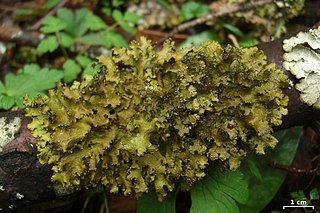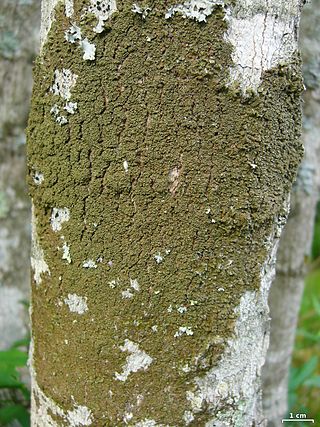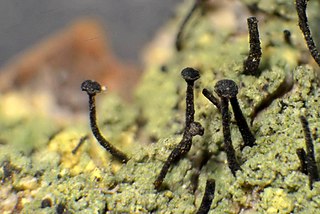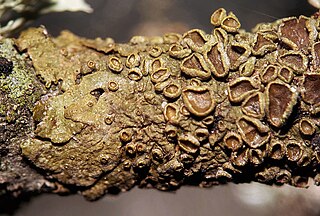
The Physciaceae are a family of mostly lichen-forming fungi belonging to the class Lecanoromycetes in the division Ascomycota. A 2016 estimate placed 19 genera and 601 species in the family.

Anaptychia is a genus of lichen-forming fungi in the family Physciaceae.

Pyxine is a genus of foliose lichens in the family Caliciaceae. The genus has a widespread distribution in tropical regions.

Physconia is a genus of lichen-forming fungi in the family Physciaceae. It has about 25 species. The genus was circumscribed by Czech lichenologist Josef Poelt in 1965, with Physconia pulverulenta assigned as the type species.

Tuckermannopsis is a genus of foliose lichens in the family Parmeliaceae.

Melanohalea is a genus of foliose lichens in the family Parmeliaceae. It contains 30 mostly Northern Hemisphere species that grow on bark or on wood. The genus is characterized by the presence of pseudocyphellae, usually on warts or on the tips of isidia, a non-pored epicortex and a medulla containing depsidones or lacking secondary compounds. Melanohalea was circumscribed in 2004 as a segregate of the morphologically similar genus Melanelia.

Cetrelia is a genus of leafy lichens in the large family Parmeliaceae. They are commonly known as sea-storm lichens, alluding to the wavy appearance of their lobes. The name of the genus, circumscribed in 1968 by the husband and wife lichenologists William and Chicita Culberson, alludes to the former placement of these species in the genera Cetraria and Parmelia.

Parmotrema is a genus of lichen belonging to the family Parmeliaceae. It is a large genus, containing an estimated 300 species, with a centre of diversity in subtropical regions of South America and the Pacific Islands.
Chicita Frances Culberson was an American lichenologist.

The Caliciaceae are a family of mostly lichen-forming fungi belonging to the class Lecanoromycetes in the division Ascomycota. Although the family has had its classification changed several times throughout its taxonomic history, the use of modern molecular phylogenetic methods have helped to establish its current placement in the order Caliciales. Caliciaceae contains 36 genera and about 600 species. The largest genus is Buellia, with around 300 species; there are more than a dozen genera that contain only a single species.

Tuckermanella is a genus of lichen-forming fungi in the family Parmeliaceae.

William Louis "Bill" Culberson was an American lichenologist.
Emodomelanelia is a lichen genus in the family Parmeliaceae. It is monotypic, containing the single foliose Himalayan species Emodomelanelia masonii.

Pyxine sorediata, commonly known as mustard lichen, is a widely distributed species of foliose lichen in the family Caliciaceae. It has a subtropical to warm temperate distribution, and grows on bark, rocks, and moss as substrates. Pyxine sorediata has been reported from regions of North America, Europe, Africa, Asia, and Australasia.
Melanohalea zopheroa is a species of lichen in the family Parmeliaceae. It was first formally described in 1977 by Ted Esslinger as Parmelia zopheroa. A year later, he transferred it to the new genus Melanelia, which he created to contain the brown Parmeliae species. In 2004, after early molecular phylogenetic evidence showed that Melanelia was not monophyletic, Melanohalea was circumscribed by lichenologists Oscar Blanco, Ana Crespo, Pradeep K. Divakar, Esslinger, David L. Hawksworth and H. Thorsten Lumbsch, and M. zopheroa was transferred to it. The lichen has a disjunct distribution, as it is found in South America (Chile) and in New Zealand.

Melanohalea subolivacea, commonly known as the brown-eyed camouflage lichen, is a species of foliose lichen in the family Parmeliaceae.

Pyxine subcinerea is a species of foliose lichen in the family Caliciaceae. It has a pantropical distribution, and typically grows on bark, but less commonly on rocks. The lichen is characterised by its yellow medulla, soralia on the margins on the lobes that make up the thallus, and the presence of the chemical lichexanthone in the cortex.
Kashiwadia is a genus of lichen-forming fungi in the family Physciaceae. The genus was circumscribed in Sergey Kondratyuk, László Lőkös, and Jae-Seoun Hur in 2014 to contain the species Physcia orientalis, after molecular phylogenetic analysis showed that the taxon occupied an isolated phylogenetic position in the Physciaceae. An additional five species were added to the genus in 2021. The genus name honours Japanese lichenologist Hiroyuki Kashiwadani, who originally described the type species.
Pyxine lyei is a species of saxicolous (rock-dwelling), foliose lichen in the family Caliciaceae. Found in East Africa, it was scientifically described as a new species in 1975 by lichenologists Dougal Swinscow and Hildur Krog. The lichen has a whitish thallus that is tightly appressed to its substrate. The lobes comprising the thallus are flat, and have faint pseudocyphellae as well as patches of pruina. The thallus underside is black; the internal medulla is white. The lichen contains triterpenoid compounds as well as lichexanthone; the latter substance causes the lichen to fluoresce when lit with a long-wavelength UV light.
Pyxine lilacina is a rare species of saxicolous (rock-dwelling), foliose lichen in the family Caliciaceae. Found in East Africa, it was scientifically described as a new species in 1975 by lichenologists Dougal Swinscow and Hildur Krog. The lichen has a brownish-grey to lilac-grey thallus that is tightly appressed to its substrate. The lobes comprising the thallus are flat, and have pseudocyphellae as well as patches of pruina. The thallus underside is black; the internal medulla is white. The lichen contains triterpenoid compounds as well as lichexanthone; the latter substance causes the lichen to fluoresce when lit with a long-wavelength UV light.













